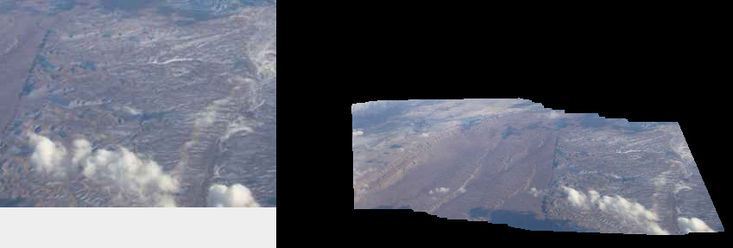Example Video Mosaic
From BoofCV
Jump to navigationJump to searchAn image mosaic is created by combining numerous images together to create one large one. In this example, it is demonstrated how to create a mosaic from a video image in real-time using a high level interface which hides much of the complexity. The mosaic is created by tracking image features and fitting a motion model (affine or homography) to the feature's location in each frame.
Example File: ExampleVideoMosaic.java
Concepts:
- Image Stitching
- Image Mosaic
- 2D image motion
Relevant Videos:
Related Examples:
Example Code
/**
* Example of how to create a mosaic from a video sequence using StitchingFromMotion2D. Mosaics work best
* when the scene being observed is far away or a flat surface. The camera motion should typically be rotational only,
* but translation can work depending on the scene's geometry. Motion blur and cheap cameras in general will degrade
* performance significantly with the current algorithm. This example just demonstrates a gray scale image, but
* with additional work color images can also be processed.
*
* @author Peter Abeles
*/
public class ExampleVideoMosaic {
public static void main( String[] args ) {
// Configure the feature detector
ConfigPointDetector configDetector = new ConfigPointDetector();
configDetector.type = PointDetectorTypes.SHI_TOMASI;
configDetector.general.maxFeatures = 300;
configDetector.general.radius = 3;
configDetector.general.threshold = 1;
// Use a KLT tracker
PointTracker<GrayF32> tracker = FactoryPointTracker.klt(4, configDetector, 3, GrayF32.class, GrayF32.class);
// This estimates the 2D image motion
// An Affine2D_F64 model also works quite well.
ImageMotion2D<GrayF32, Homography2D_F64> motion2D =
FactoryMotion2D.createMotion2D(220, 3, 2, 30, 0.6, 0.5, false, tracker, new Homography2D_F64());
// wrap it so it output color images while estimating motion from gray
ImageMotion2D<Planar<GrayF32>, Homography2D_F64> motion2DColor =
new PlToGrayMotion2D<>(motion2D, GrayF32.class);
// This fuses the images together
StitchingFromMotion2D<Planar<GrayF32>, Homography2D_F64>
stitch = FactoryMotion2D.createVideoStitch(0.5, motion2DColor, ImageType.pl(3, GrayF32.class));
// Load an image sequence
MediaManager media = DefaultMediaManager.INSTANCE;
String fileName = UtilIO.pathExample("mosaic/airplane01.mjpeg");
SimpleImageSequence<Planar<GrayF32>> video =
media.openVideo(fileName, ImageType.pl(3, GrayF32.class));
Planar<GrayF32> frame = video.next();
// shrink the input image and center it
Homography2D_F64 shrink = new Homography2D_F64(0.5, 0, frame.width/4, 0, 0.5, frame.height/4, 0, 0, 1);
shrink = shrink.invert(null);
// The mosaic will be larger in terms of pixels but the image will be scaled down.
// To change this into stabilization just make it the same size as the input with no shrink.
stitch.configure(frame.width, frame.height, shrink);
// process the first frame
stitch.process(frame);
// Create the GUI for displaying the results + input image
ImageGridPanel gui = new ImageGridPanel(1, 2);
gui.setImage(0, 0, new BufferedImage(frame.width, frame.height, BufferedImage.TYPE_INT_RGB));
gui.setImage(0, 1, new BufferedImage(frame.width, frame.height, BufferedImage.TYPE_INT_RGB));
gui.setPreferredSize(new Dimension(3*frame.width, frame.height*2));
ShowImages.showWindow(gui, "Example Mosaic", true);
boolean enlarged = false;
// process the video sequence one frame at a time
while (video.hasNext()) {
frame = video.next();
if (!stitch.process(frame))
throw new RuntimeException("You should handle failures");
// if the current image is close to the image border recenter the mosaic
Quadrilateral_F64 corners = stitch.getImageCorners(frame.width, frame.height, null);
if (nearBorder(corners.a, stitch) || nearBorder(corners.b, stitch) ||
nearBorder(corners.c, stitch) || nearBorder(corners.d, stitch)) {
stitch.setOriginToCurrent();
// only enlarge the image once
if (!enlarged) {
enlarged = true;
// double the image size and shift it over to keep it centered
int widthOld = stitch.getStitchedImage().width;
int heightOld = stitch.getStitchedImage().height;
int widthNew = widthOld*2;
int heightNew = heightOld*2;
int tranX = (widthNew - widthOld)/2;
int tranY = (heightNew - heightOld)/2;
Homography2D_F64 newToOldStitch = new Homography2D_F64(1, 0, -tranX, 0, 1, -tranY, 0, 0, 1);
stitch.resizeStitchImage(widthNew, heightNew, newToOldStitch);
gui.setImage(0, 1, new BufferedImage(widthNew, heightNew, BufferedImage.TYPE_INT_RGB));
}
corners = stitch.getImageCorners(frame.width, frame.height, null);
}
// display the mosaic
ConvertBufferedImage.convertTo(frame, gui.getImage(0, 0), true);
ConvertBufferedImage.convertTo(stitch.getStitchedImage(), gui.getImage(0, 1), true);
// draw a red quadrilateral around the current frame in the mosaic
Graphics2D g2 = gui.getImage(0, 1).createGraphics();
g2.setColor(Color.RED);
g2.drawLine((int)corners.a.x, (int)corners.a.y, (int)corners.b.x, (int)corners.b.y);
g2.drawLine((int)corners.b.x, (int)corners.b.y, (int)corners.c.x, (int)corners.c.y);
g2.drawLine((int)corners.c.x, (int)corners.c.y, (int)corners.d.x, (int)corners.d.y);
g2.drawLine((int)corners.d.x, (int)corners.d.y, (int)corners.a.x, (int)corners.a.y);
gui.repaint();
// throttle the speed just in case it's on a fast computer
BoofMiscOps.pause(50);
}
}
/**
* Checks to see if the point is near the image border
*/
private static boolean nearBorder( Point2D_F64 p, StitchingFromMotion2D<?, ?> stitch ) {
int r = 10;
if (p.x < r || p.y < r)
return true;
if (p.x >= stitch.getStitchedImage().width - r)
return true;
if (p.y >= stitch.getStitchedImage().height - r)
return true;
return false;
}
}
